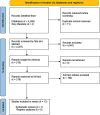Mesh versus non-mesh repair of groin hernias: a rapid review
- PMID: 35451174
- PMCID: PMC9790697
- DOI: 10.1111/ans.17721
Mesh versus non-mesh repair of groin hernias: a rapid review
Abstract
Background: Mesh is frequently utilized intraoperatively for the repair of groin hernias. However, patients may request non-mesh hernia repairs owing to adverse events reported in other mesh procedures. To inform surgical safety, this study aimed to compare postoperative complications between mesh and non-mesh groin hernia repairs and identify other operative and patient-related risk factors associated with poor postoperative outcomes.
Methods: Ovid MEDLINE and grey literature were searched to 9 June 2021 for studies comparing mesh to non-mesh techniques for primary groin hernia repair. Outcomes of interest were postoperative complications, recurrence of hernia, pain and risk factors associated with poorer surgical outcomes. Methodological quality was appraised using the AMSTAR 2 tool.
Results: The systematic search returned 4268 results, which included seven systematic reviews and five registry analyses. Mesh repair techniques resulted in lower hernia recurrence rates, with no difference in chronic pain, seroma, haematoma or wound infection, compared to non-mesh techniques. Risk factors associated with increased risk of hernia recurrence were increased body mass index (BMI), positive smoking status and direct hernia. These were independent of surgical technique. Patients under 40 years of age were at increased risk of postoperative pain.
Conclusions: Surgical repair of primary groin hernias using mesh achieves lower recurrence rates, with no difference in safety outcomes, compared with non-mesh repairs. Additional risk factors associated with increased recurrence include increased BMI, history of smoking and hernia subtype.
Keywords: hernia; mesh; rapid review; recurrence; safety; surgery.
© 2022 The Authors. ANZ Journal of Surgery published by John Wiley & Sons Australia, Ltd on behalf of Royal Australasian College of Surgeons.
Conflict of interest statement
None declared.
Figures
References
-
- Australian Government Department of Health TGA . Therapeutic goods administration. TGA actions after review into urogynaecological surgical mesh implants. [Cited 2 Sep 2020.] Available from URL: https://www.tga.gov.au/hubs/transvaginal-mesh 2020).
Publication types
MeSH terms
LinkOut - more resources
Full Text Sources


